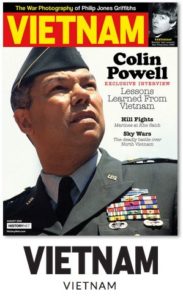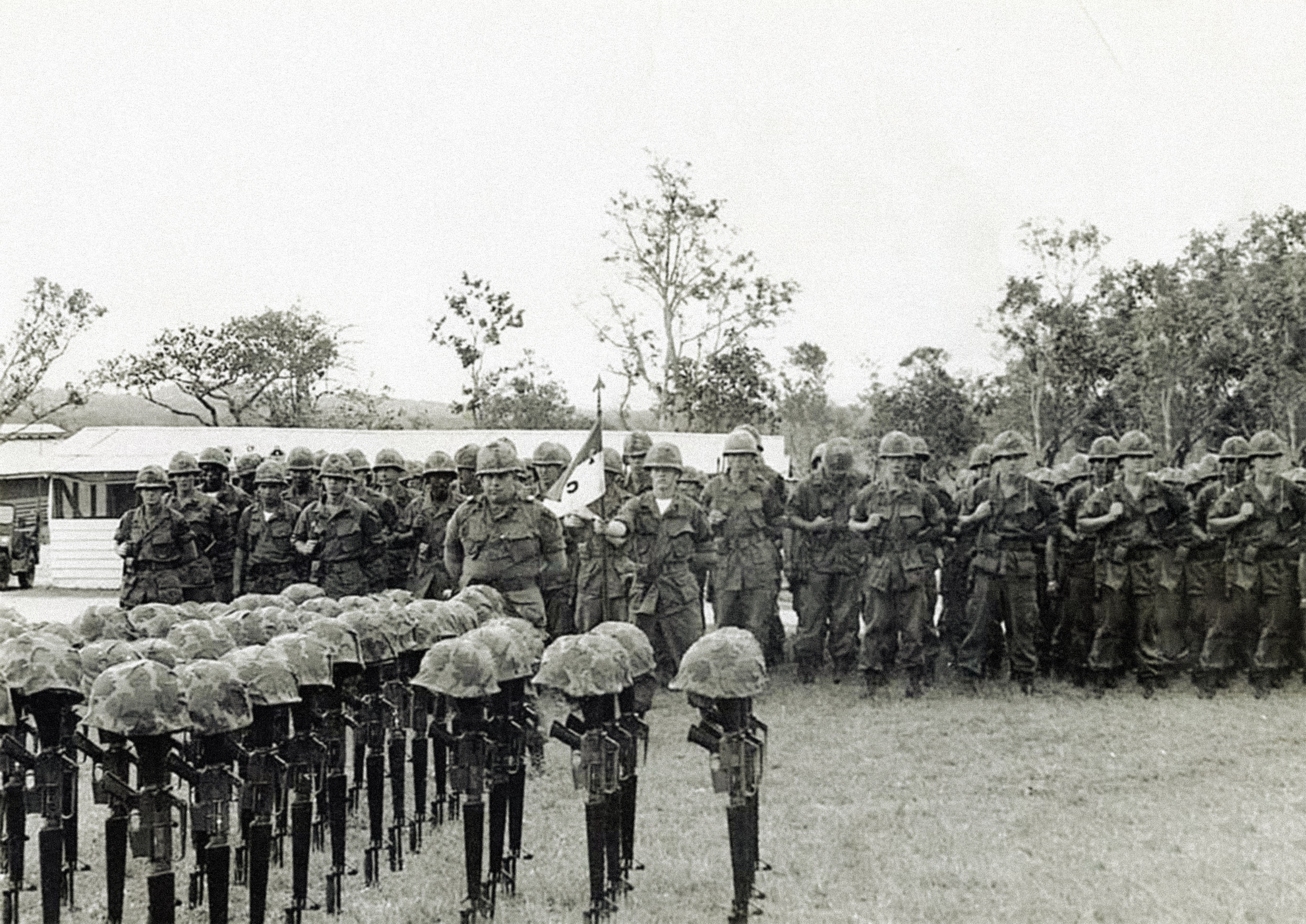I joined Charlie Company’s 1st Platoon as a private first class around Labor Day 1966, about two weeks after six men in the company were killed and others wounded in the Ia Drang Valley of South Vietnam’s Central Highlands. I was one of about 30 to 35 replacements sent in late August and early September to the company, part of 1st Battalion, 5th Cavalry Regiment, 1st Cavalry Division (Airmobile). Charlie Company returned to the valley on a reconnaissance mission a few days before Thanksgiving.
During September and October, we had been operating in the central coastal mountains and plains of Binh Dinh province, where we lost 11 men to combat, drowning and friendly fire. We then flew on short notice to the Cambodian border to join the 4th and 25th Infantry divisions in Operation Paul Revere IV, a search-and-destroy mission focused on the Plei Trap Valley northwest of the Duc Co Special Forces camp. Two 1st Cav battalions were sent to cover the infantry divisions’ rear and block enemy movements through the Ia Drang Valley south of the camp. When we learned where we were going, the older guys told the new men they would be earning their Combat Infantry Badge soon.
Traces of the Past Battle
The 1st Cav had a history in that valley. The first clash between battalion-sized units of the U.S. Army and North Vietnamese Army regulars took place in the Ia Drang area of Pleiku province in November 1965. Helicopter-borne 1st Cav troops dropped at Landing Zone X-Ray on Nov. 14 soon were attacked by the NVA but eventually repulsed the enemy. On Nov. 17, 1st Cav troops at nearby LZ Albany were ambushed and suffered severe losses before reinforcements arrived. Close to 300 Americans were killed at those two sites and related fighting.
Both sides learned lessons from that fight. We learned to rely on massive supporting fire and quick reinforcement from the air, while the enemy learned to fight us as close as possible—to “cling to our belts,” making it harder for U.S. air support to target the enemy without hitting our own troops.
In the first two weeks of November 1966, we went in and out of the valley. The only sign of the NVA was a skull found in the underbrush—a relic from the previous year’s fighting. Yet we never shook the eerie feeling that we were being watched.
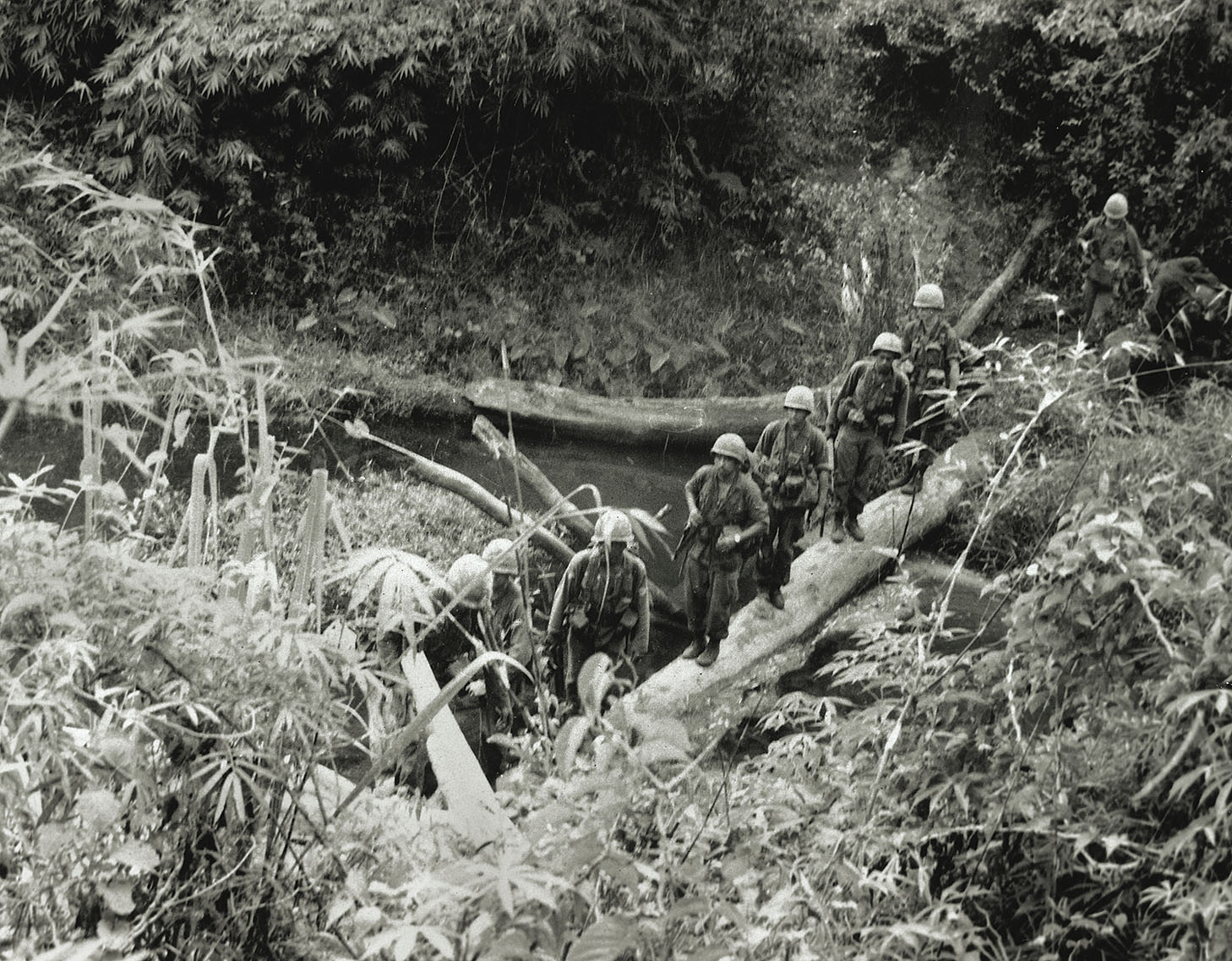
About halfway through November, we got a new company commander, Capt. Harold Wunsch, coming from a staff job at battalion headquarters. A few days after Wunsch arrived, he called Charlie Company together and told us we would go back into the valley to intercept communist couriers crossing the Cambodian border.
We later learned the 1st Cav had solid intelligence indicating that fresh NVA regiments in Cambodia were ready to enter South Vietnam. For years I believed that our commanding officer lied to us, but I know now it’s possible the intel never filtered down to him. The commander of another company in our battalion recalled that “down at our level, we were like mushrooms … kept in the dark and fed with lots of BS.”
On Nov. 19, a scout chopper spotted about 20 enemy soldiers just inside the border. Charlie Company was helicoptered into a small clearing to check it out. Each of our platoons patrolled in a different direction. We noticed fresh trails through the brush but didn’t find any NVA. As night fell on the 20th, my platoon, 1st Platoon, had not linked up with the other platoons, so we set up an ambush about 900 yards south of them.
Warning Signs
The 2nd and 3rd platoons set up ambush positions about 200 yards apart. The 3rd Platoon was along a well-used trail. During the night NVA troops probed its position. One NVA soldier was killed. Three or four others faded like shadows back into the jungle and darkness, as one of them yelled: “Tomorrow, you die GI!”
An experienced squad leader in 3rd Platoon, Sgt. Henry Brown, continued to report movement during the night. However, our captain, who was with 2nd Platoon, dismissed those reports, attributing them to the man’s jitteriness. Another squad leader heard a strange noise. At first light, he discovered the gruesome origin of the sound—hundreds of red army ants chewing on the dead NVA soldier’s exposed flesh. The corpse was wearing a fresh uniform and had a new AK-47 assault rifle.
Early in the morning on Nov. 21, my platoon chowed down on C rations and then moved farther from the company to set up a blocking position. The 2nd and 3rd platoons planned to combine forces and sweep toward my 1st Platoon and drive the NVA into our field of fire.
By 10 a.m. we were roughly a mile south of the other platoons. The 3rd Platoon remained at its ambush position, where it was joined the by 2nd Platoon and Wunsch’s company command group. A Huey helicopter dropped supplies for them.
The leader of 3rd Platoon, a platoon sergeant, picked up the dead NVA soldier’s AK-47 and emptied the magazine into the corpse’s head. He supposedly did this to show the new men the serious nature of war. However, the sergeant himself was new—a replacement for a platoon sergeant wounded in mid-October.
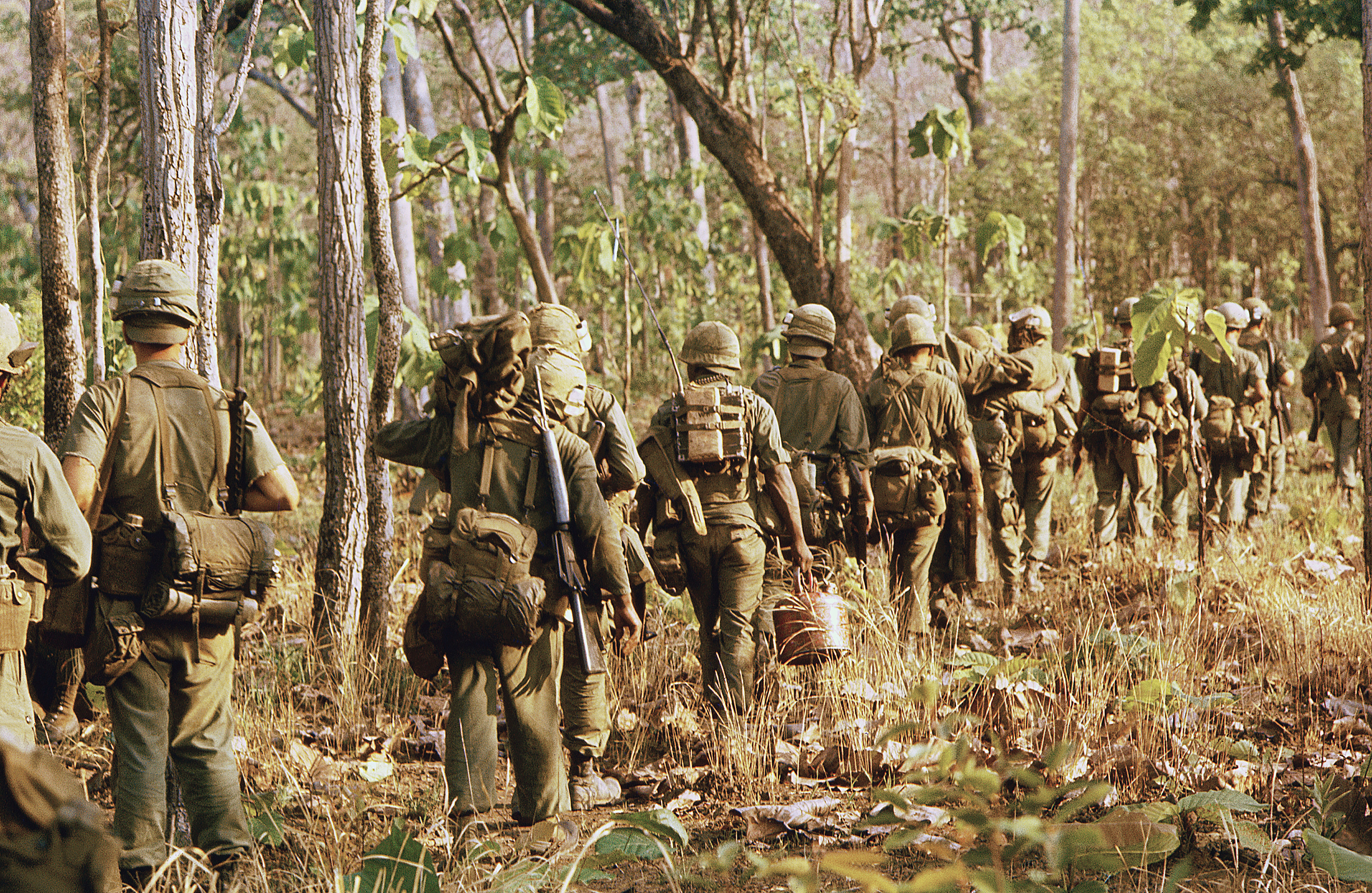
The 3rd Platoon had a man sick with abdominal pains. There was no nearby clearing for a medevac, so Wunsch ordered a 13-man squad under Brown to take the sick man to LZ Hawk, about a mile northeast of their position. The remaining 22 men of 3rd Platoon would stay put until Brown’s squad returned, while Wunsch and 2nd Platoon began a wider sweep with 35 to 40 men.
The rest of our battalion was widely scattered. The closest troops were two platoons of Alpha Company about a mile north of us. Mutual support was impossible.
At about 9:30 a.m., 2nd Platoon spotted the NVA moving along the border. As the platoon turned, the North Vietnamese disappeared into the high grass close to a small knoll. Wunsch ordered recon by fire—shooting to draw a response that would reveal the enemy’s position—and called in artillery. The platoon spotted five or six NVA men standing on the knoll and facing the other direction.
Heading Into A Trap
Wunsch believed the NVA was unaware of the platoon’s presence, despite our artillery and small arms fire. As the captain moved the platoon into position to sweep the knoll, forward observer Spc. 4 Bill Tuey, our company’s liaison with artillery units, warned Wunsch he was heading into a trap.
The 2nd Platoon advanced toward the knoll and fired on the NVA, killing some. As the platoon reached the knoll’s base, the NVA opened up with machine gun and AK-47 fire, hitting several of our men. At approximately 10:05 a.m., Wunsch radioed the battalion commander, Lt. Col. Robert Siegrist, to report that 2nd Platoon had killed six to eight NVA fighters. “I think we’re holding our own,” he added, even though the platoon was already pinned down in the high grass and NVA soldiers on the higher ground simply fired wherever they saw the grass move.
About 10 or 15 minutes into the fight, Wunsch radioed 3rd Platoon, about 200 yards away, to come to the aid of 2nd platoon. As 3rd Platoon moved out, it was attacked on all sides by an NVA force of at least company strength. The North Vietnamese had crawled undetected through the high grass and almost immediately placed a light machine gun in the position that 3rd Platoon had just vacated as it moved out.
Meanwhile, 2nd Platoon’s fight devolved into small battles for survival led by the platoon sergeant and squad leaders. Both Wunsch and the 2nd Platoon leader were wounded early in the fight and given morphine by a medic. As 3rd Platoon was fending off the NVA, the volume of fire became so great that 2nd Platoon could hear it. Wunsch, likely feeling the morphine, told his radioman to contact 3rd Platoon and “tell them to quit their damn firing.”
Tuey called for artillery support from a battery of 105 mm howitzers. Still a few weeks short of his 19th birthday, he became one of 2nd Platoon’s leaders, effectively handling all supporting fire and communication with the other platoons from that point on. When the NVA attacked 3rd Platoon, its radioman, Pfc. John Godfrey, told Tuey the platoon was taking fire.
Minutes later, Godfrey radioed that they were surrounded by NVA attacking with hand grenades. He asked for artillery fire directly on 3rd Platoon’s position. Tuey immediately called a fire mission, but it was delayed until the battalion commander’s chopper cleared the area. After the first rounds, Godfrey asked for the artillery to be brought closer. Tuey readjusted the coordinates. The full battery fired in support of the surrounded platoon.
Tuey got a call from Godfrey saying the rounds were on target and to keep them coming.
The Last Contact
That was the last contact with 3rd Platoon. Tuey tried to raise Godfrey, but got no response. He told him to press the talk button on the radio’s handset if he was alive but unable to talk. Tuey heard gunshots and people speaking Vietnamese before the radio went dead. While Tuey was handling most of the direct contact with 3rd Platoon, Wunsch radioed battalion leader Siegrist and told him 3rd Platoon was surrounded. About five minutes later, he reported: “We probably have lost them.”
The ambush of 3rd Platoon probably lasted no more than 15 or 20 minutes before the unit was overrun. Only two survived, and each recalls being the last man firing. Sgt. Julius Durham was hit in the arm trying to lead his squad to break the ambush. Pfc. Anthony Gray, an ammo bearer for a machine gun, kept firing with his rifle and throwing grenades after the machine gunner and assistant gunner were hit. After his M16 rifle jammed, Gray was hit in the eye and jaw by rifle fire and grenade fragments.
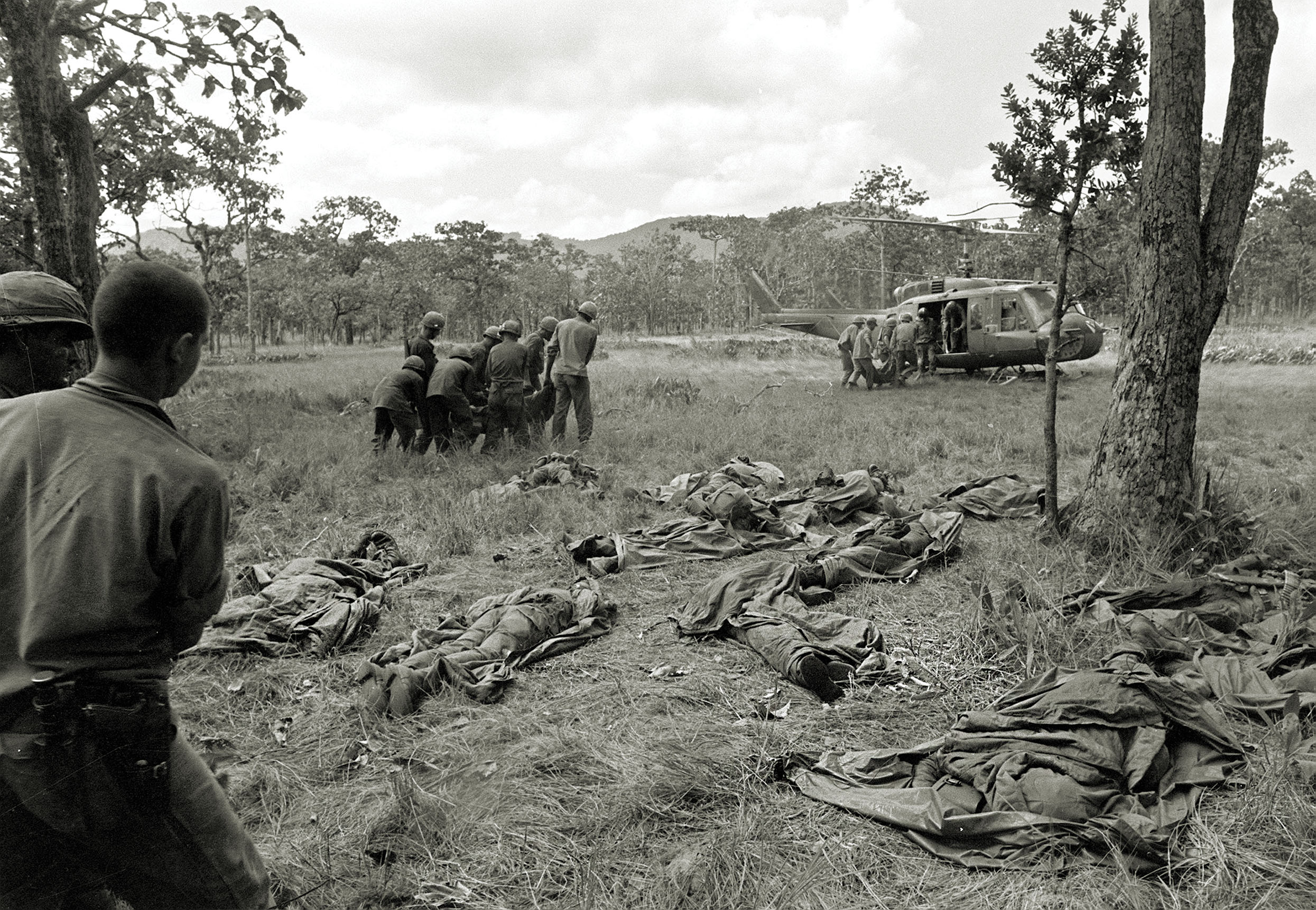
Durham and Gray played dead as the NVA moved through the area, killing the wounded and taking their weapons. One of them grabbed Godfrey’s radio. When an NVA soldier yanked Gray’s rifle out of his hand, the private involuntarily jerked, but the enemy didn’t shoot him. The NVA soldiers who ambushed 3rd Platoon turned their attention to 2nd Platoon, still trapped at the base of the knoll about 200 yards away, and attacked with rocket-propelled grenades.
Shortly after the fight started, Wunsch had ordered 1st Platoon to rejoin the rest of the company, and Siegrist ordered Alpha Company’s two platoons to link up with Charlie Company. Both groups had just started to move when 3rd Platoon was ambushed. At the same time, Brown and his 3rd Platoon squad transporting the sick man had gone just a few hundred yards when they heard the call from Godfrey telling Tuey their platoon was surrounded.
Brown’s men, however, were unable to make radio contact with the rest of the company. They paused briefly and considered turning back, but sporadic fire from the NVA clearly indicated they were being tracked, so they continued on to LZ Hawk. A mortar platoon there fired shots to guide them, and they reached the landing zone without casualties. A scout chopper later reported as many as 100 North Vietnamese were in pursuit.
Napalm And Cannon Fire
As my platoon moved toward the besieged 2nd Platoon, we started jogging but couldn’t sustain that pace because we were in full gear and slowed by patches of bamboo, high grass and sharp, thorn-covered vines. Uncertain of 2nd Platoon’s location, we headed toward the firing, but got lost. We apparently bypassed the platoon and crossed into Cambodia before we fixed on its location.
We reached 2nd Platoon shortly after an airstrike unleashed napalm and cannon fire on NVA positions atop the knoll. Airstrikes were usually executed smoothly and without delay, but that day something broke down. It took almost an hour for the Army’s Huey gunships to arrive, and when they did the thick jungle canopy dispersed the impact of their rockets. The munitions had little effect. No one at the battalion or brigade level requested support from the Air Force until at least 11:30 a.m. The first airstrike did not arrive until after noon.
The 2nd Platoon was fighting a much larger force for more than two hours before effective air support reached it. Twice-wounded machine gunner Pfc. John Dalton held off the NVA long enough for the airstrikes to arrive and stayed at his gun until he lost consciousness.
When help came, the strike was carried out by slow but accurate A-1 Skyraider attack planes. The Skyraiders dropped napalm canisters directly on the NVA on the knoll and followed up with strafing runs using their cannons. The men in 2nd Platoon felt the intense heat from the napalm and saw NVA soldiers running through the flames. By that time, more than half of the platoon was dead or wounded. Probably 10 to 12 men had been holding off at least two NVA companies.
As we linked up with 2nd Platoon from their rear, the NVA broke off its attack and retreated into Cambodia. A few shots were fired in our direction, but mostly silence settled back into the valley. Our platoon leader, Lt. Tim McCarthy, stopped us while he and a few others crawled up to find Wunsch who, still under the effects of morphine, told him, “I don’t think we got anyone killed.”
McCarthy then took a few men forward. They crested the knoll and saw the destructive power of the airstrikes against the NVA forces there.
As McCarthy’s crew returned to the captain, they passed by the platoon’s right flank and found everyone there dead except for Dalton, still unconscious. The brave machine gunner died before he could be medevaced.
Jammed M16 Rifles
The first man I saw had a jammed M16 rifle. Others also had M16s that were hopelessly jammed. Some survivors said they had to toss working M16s back and forth to each other during the fight. In the early model M16s a cartridge would get stuck in the rifle’s chamber and you had to run a cleaning rod down the barrel to knock it out—very difficult to do under fire. Some men didn’t have cleaning rods because the Army failed to provide enough cleaning kits. We had about one cleaning rod for every three or four riflemen. It’s impossible to know how many men had jammed M16s that day, but it’s a fact that some men of 2nd and 3rd platoons died holding a rifle that couldn’t fire. I gave my cleaning rod to the soldier I saw and asked him to pass it down the line.
McCarthy told me to collect the dog tags from the casualties on the right flank. I found two friends of mine, Pfc. Joe Scicutella from the Bronx and Pfc. Joe Rabon from South Carolina, lying within a few feet of each other. I had gone through basic training with them, and we came to Charlie Company as replacements at the same time. Scicutella and Rabon had become best friends in training and asked to be in the same squad.
After collecting what dog tags I could find, I joined other men trying to cut down trees to make a clearing for medevac choppers. The trees were tropical ironwood, and all we had were machetes. We hacked away but barely scratched the bark. To get the wounded out, we had to use a medevac helicopter equipped with a hoist. It hovered over the trees and lowered a stretcher attached to a cable. A wounded soldier was strapped onto the stretcher and held upright until he was slowly winched up through the trees and hauled into the chopper.
One Casualty At A Time
There was only one medevac chopper with a hoist, and it could only take one casualty at a time. The pilot had to fly each man to a secure landing zone to transfer him to another helicopter and then fly back for the next trooper. As 2nd Platoon’s wounded men were pulled up through the jungle, blood dripped on the men steadying the stretchers.
Around the time we linked up with Charlie’s 2nd Platoon, two platoons of Alpha Company reached the scene of 3rd Platoon’s ambush. They found 19 men dead and three wounded—Durham and Gray, who had played dead, and a third man, who would die without regaining consciousness. Alpha left some men to secure the area and moved to our position. As they approached, they were fired on by nervous members of our company’s 1st and 2nd platoons. After establishing radio contact with us, finding our position secure and the fight over, Alpha began evacuating 3rd Platoon’s dead and wounded.
It was late afternoon before the dead could be taken out. At the 2nd and 3rd platoon ambush sites, a CH-47 Chinook transport helicopter dropped a cargo net that was spread on the ground. We wrapped the dead in ponchos and stacked them on the net, two and three deep. Their equipment was thrown on top of them. Then the nets were secured, hooked to a cable and hoisted through the trees by the hovering Chinook, which flew away with the net hanging beneath it, taking the dead to the rear and an early return home.
Charlie Company lost 34 men killed and 11 to 14 wounded, out of 55 to 60 soldiers from the 2nd and 3rd platoons and the company’s command post. Over a third had been in Vietnam about a month or less and died in their first battle.
Thanksgiving
The NVA troops who attacked Charlie Company were part of the 101C Regiment, which had recently come down the Ho Chi Minh Trail. They were wearing clean khaki uniforms and carrying weapons that worked effectively under fire. The day after the battle, Nov. 22, our battalion operations log reported the “final” count of enemy casualties was 119 NVA killed and 75 wounded. Then it was revised up to 145 enemy dead. Subsequently, battalion commander Siegrist estimated total enemy losses, killed and wounded, as “near the 300 mark.”
Two days after the battle was Thanksgiving. The Army brought turkey dinners to units in the field. No one told our support units that half the company was gone, so we got food for twice as many men. We sat in silence gorging ourselves on turkey, stuffing, mashed potatoes and ice cream.
A short while later, the Army declared victory. The 1st Cav’s in-house newspaper, the Cavalair, said we mauled the NVA and won a fierce fight against a much larger force. An after-action report claims that NVA forces planned to attack a nearby Special Forces camp and that we caused them “to abort the attack plan as it had lost the element of surprise.”
I never believed that. NVA units could have easily maneuvered around us if that was their intent. As soon as Charlie Company landed in the Ia Drang Valley on Nov. 19, we became the target.
Last Ones Standing
Some veterans say we never lost a battle because the enemy usually broke contact first and left us in possession of the battlefield. That claim never made sense to me. Our strategy in Vietnam was not to take and hold land, but to draw the NVA into battles of attrition.
The Ia Drang Valley had no value except as a place to find and fight the NVA. Charlie Company’s men may have been the last ones standing on a remote patch of ground in the valley the evening of Nov. 21, but the Army abandoned the ground the next day—as it did at so many other remote clearings, hilltops and valleys in the borderlands of Vietnam.
As for the North Vietnamese infantrymen who also fought and died for the same remote patch of jungle, Tuey summed it up best: “When checking the bodies of the dead NVA, I discovered a wallet on one of the soldiers. He was one of the NVA I had shot and I had seen him fall when I shot him. Inside was a picture of what appeared to be his wife and young son. This was the first time I was able to humanize the NVA soldiers and understand they were fighting for a cause and were no different than us, only on the other side.” V
Steve Hassett enlisted in early 1966 and served in Vietnam August 1966-August 1967, ending his tour as a sergeant and squad leader. He later was an intelligence analyst with the 8th Army in Korea. After his discharge in 1968, Hassett went to college, was active in Vietnam Veterans Against the War, got a law degree and spent most of his career with the Washington State Attorney General’s Office. He lives in Buffalo, New York.
This article appeared in the August 2021 issue of Vietnam magazine. For more stories from Vietnam magazine, subscribe here and visit us on Facebook:
